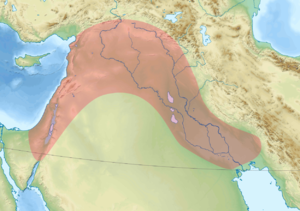
Fertile Crescent
Background Information
This content from Wikipedia has been selected by SOS Children for suitability in schools around the world. To compare sponsorship charities this is the best sponsorship link.
The Fertile Crescent is a region in Western Asia. It includes the comparatively fertile regions of Mesopotamia and the Levant, delimited by the dry climate of the Syrian Desert to the south and the Anatolian highlands to the north. The region is often considered the cradle of civilization, saw the development of many of the earliest human civilizations, and is the birthplace of writing and the wheel.
The term "Fertile Crescent" was first used by University of Chicago archaeologist James Henry Breasted in his Ancient Records of Egypt, published in 1906. The region was so named due to its rich soil and crescent shape.
Modern-day countries with significant territory within the Fertile Crescent are Iraq, Jordan, Lebanon, Syria, Israel and the Palestinian Territories, besides the southeastern fringe of Turkey and the western fringe of Iran.
Geography
As crucial as rivers and marshlands were to the rise of civilization in the Fertile Crescent, they were not the only factor in the area's precocity. The area is important as the "bridge" between Africa and Eurasia. This "bridging role" has allowed the Fertile Crescent to retain a greater amount of biodiversity than either Europe or North Africa, where climate changes during the Ice Age led to repeated extinction events due to ecosystems becoming squeezed against the waters of the Mediterranean Sea. Coupled with the Saharan pump theory, this Middle Eastern land-bridge is of extreme importance to the modern distribution of Old World flora and fauna, including the spread of humanity.
The fact that this area has borne the brunt of the tectonic divergence between the African and Arabian plates, and the converging Arabian and Eurasian plates, has also made this region a very diverse zone of high snow-covered mountains, fertile broad alluvial basins and desert plateau, which has also increased its biodiversity further and enabled the survival into historic times of species not found elsewhere.
Climate and vegetation
The Fertile Crescent had a diverse climate, and major climatic changes encouraged the evolution of many "r" type annual plants, which produce more edible seeds than "K" type perennial plants. The region's dramatic variety of elevation gave rise to many species of edible plants for early experiments in cultivation. Most importantly, the Fertile Crescent possessed the wild progenitors of the eight Neolithic founder crops important in early agriculture (i.e. wild progenitors to emmer wheat, einkorn, barley, flax, chick pea, pea, lentil, bitter vetch), and four of the five most important species of domesticated animals—cows, goats, sheep, and pigs—and the fifth species, the horse, lived nearby. As a result the Fertile Crescent has an impressive record of past human activity. As well as possessing many sites with the skeletal and cultural remains of both pre-modern and early modern humans (e.g. at Kebara Cave in Israel), later Pleistocene hunter-gatherers and Epipalaeolithic semi-sedentary hunter-gatherers (the Natufians), this area is most famous for its sites related to the origins of agriculture. The western zone around the Jordan and upper Euphrates rivers gave rise to the first known Neolithic farming settlements (referred to as Pre-Pottery Neolithic A ( PPNA)), which date to around 9,000 BC (and includes sites such as Jericho). This region, alongside Mesopotamia (which lies to the east of the Fertile Crescent, between the rivers Tigris and Euphrates), also saw the emergence of early complex societies during the succeeding Bronze Age. There is also early evidence from this region for writing, and the formation of statelevel societies. This has earned the region the nickname "The Cradle of Civilization."
Both the Tigris and Euphrates start in the Taurus Mountains of what is today Turkey. Farmers in southern Mesopotamia had to protect their fields from flooding each year, except Northern Mesopotamia which had just enough rain to make some farming possible. To protect floods from coming, they made levees.
Since the Bronze Age, the region's natural fertility has been greatly extended by irrigation works, upon which much of its agricultural production continues to depend. The last two millennia have seen repeated cycles of decline and recovery as past works have fallen into disrepair through the replacement of states, to be replaced under their successors. Another ongoing problem has been salination — gradual concentration of salt and other minerals in soils with a long history of irrigation.
In the contemporary era, river waters remain a potential source of friction in the region. The Jordan lies on the borders of Israel, the kingdom of Jordan and the areas administered by the Palestinian Authority. Turkey and Syria each control about a quarter of the river Euphrates, on whose lower reaches Iraq is heavily dependent.


